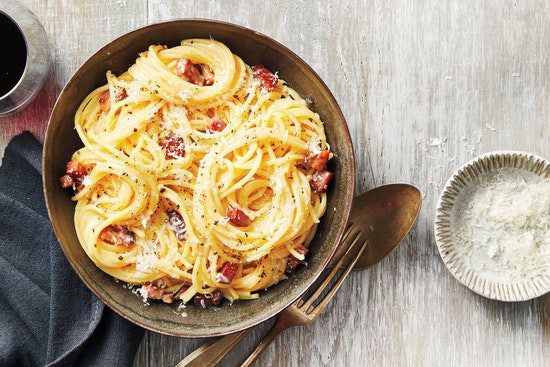LA CARBONARA Cooking Lesson
Often bastardized and wrongly executed, Carbonara promises a pleasant change in the pasta category, once you use the best ingredients.
Flavors and Knowledge
Jan 20
FOTO: {Spaghetti Carbonara Image Attribution via Wine Enthusiast}
Flavors + Knowledge is a reader-supported publication. To receive new posts and support my work, consider becoming a free or paid subscriber.
Buongiorno amici:
Last week, I received several e-mails regarding a tested recipe for Carbonara, and here I am re-posting a good version I have used for over 30 years. I hope it works for you as well.
“Pasta Carbonara,” as we call it here in the States, is one of the most famous Italian recipes in the world, also one that’s frequently bastardized, modified, analyzed, and wrongly executed.
I always remind those who attempt to cook, to choose ingredients wisely, keep simplicity, and respect guidelines by cooking for others’ palates and not their own.
The origin of the carbonara sauce is unknown, and there are many variations. But only one is the authentic one, and below you will have it to try. Perhaps born between the city of Rome and the nearby region of Abruzzo, the sauce is one of the most famous examples of Italian cooking. But, unfortunately, no written records, no text that talks about this dish, or rather, no one has ever talked about this condiment until the 1950s.
However, it has entered into the long list of classics with time. Its fame has grown over time, and April 6th is Carbonara Day. This celebration unites fans globally except in England, where the egg does not appear in the preparation, replaced by heavy cream. But I am not surprised, the Anglo-Saxons were never inventors of elaborate cuisine, and their palates reflect the limited selection available within their territories.
Using a few quality ingredients is the secret to a good result. First, you need the guanciale, the pork part that goes from the cheek to the neck, Pecorino Romano, aged over 12 months, eggs, and pepper. In the United States, many restaurants use Parmigiano Reggiano, but Pecorino Romano is the cheese to use. Be inquisitive when a menu list “cheese”, because it could be a blend of various cheeses.
Share
Spaghetti alla Carbonara
Ingredients for 4
Two eggs, plus one egg yolk, room temperature (use organic if possible)
One teaspoon fresh-ground black pepper
3 ounces Pecorino Romano (or half Parmigiano, half Pecorino Romano), finely grated
12 ounces dry spaghetti, or favorite cut of pasta (spend on good quality pasta, wheat differs on various labels)
4 ounces guanciale or untreated pancetta, cut into ¼-inch dice, or thinly sliced
Salt, to taste
Directions
In a large bowl, whisk eggs, yolk, pepper, and two ¼ ounces of cheese. Set aside.
Bring a lightly salted pot of water to boil over high heat. Add spaghetti, and cook according to package directions.
Meanwhile, warm a large, heavy-bottomed skillet (not nonstick) over medium heat. Add pancetta, and cook until golden brown and almost crispy, 6–8 minutes. Lower heat, and keep warm.
Reserve ½ cup pasta water and drain pasta. Add spaghetti to skillet with pancetta. Using tongs or wooden spoons, toss pasta with a pancetta. Turn off heat.
Whisk together reserved pasta water and egg mixture, then pour into pan. Working quickly, toss the pasta to coat until sauce is thick and glossy. Add salt to taste.
Sprinkle remaining cheese on top. Serve immediately.
Note: the guanciale may be an ingredient that is not found everywhere. If you live within an area of great Italian specialties, opt to use instead of pancetta, or bacon, which is the last option available.

{Guanciale Image Attribution via Taste Atlas}
Get 20% off for 1 year
Share Flavors + Knowledge
Thanks for reading. Eat safe and wear a mask! Ciao Chef W
Flavors + Knowledge Podcast
Flavors + Knowledge Newsletter
SAPERE + SAPORI Italian Newsletter
YouTube News you can eat 24
Support Chef Walters Children’s Diabetes Foundation
Corporate Website with other businesses and Services
Note: The views and opinions expressed in the Flavors and Knowledge newsletters are those of the authors and do not necessarily reflect Flavors and Knowledge’s official policy or position. Our blogger’s or authors’ content is of their opinion and not intended to malign any religion, ethnic group, club, organization, company, individual, or anyone. Any general advice posted on our blog, Website, or app is only for informational purposes and not to replace any medical or other advice.
Like Comment
Share
You’re a free subscriber to Flavors + Knowledge. For the full experience, become a paid subscriber.
Subscribe
© 2022 Chef Walters Cooking School Unsubscribe
CWCS 162 Mayfield Avenue Cranston Rhode Island 02920













